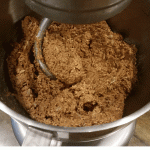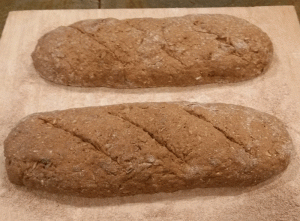| Rye %: | 36% |
| Stages: | Scald, Final dough |
| Leaven: | Instant yeast |
| Start to Finish: | 4½-5 hours |
| Hands-on Time: | 20-30 minutes |
| Yield: | Two 2¾ lb/785 g loaves |
Thinking about my third and final holiday bread for 2016, I decided that I wanted something halfway between the savory Christmas Crispbread and sweet Bavarian Ketzapiren I’d already posted. This Hazelnut-Fig Loaf immediately came to mind. Like many Finnish Christmas loaves, this one is based on a mixed wheat-rye dough, sweetened with syrup and enhanced with the sweet-bitter notes of roasted barley malt. What sets this one apart is its use of chopped figs and hazelnuts, sunflower seeds and coarse rye meal. All of these combine to produce a coarse, complex mouth feel that plays beautifully against an equally complex flavor profile of understated sweetness, nuttiness, coffee and subtle sour.
The original recipe calls for “beer malt” (kaljamaltaita) with no further information. Since I had some Crystal malt L70, a dark-roasted barley with strong coffee notes, I used that, which also, by the way reflects the Finns’ preference for porter and other strong dark beers. Instead of putting the malted barley into the soaker, husks and all, I ground it fine in my grain mill (a spice mill, blender or food processor works equally well) and sifted out the husks. Most home brewing outlets carry a wide variety of beer malts, from the very mild and sweet to the deeply bitter; choose a malt that reflects your tastes.
I brought one of the loaves, generously sprinkled with powdered sugar, to a friend’s annual Christmas Eve open house, where it paired beautifully with a glass of glögg. The other we saved for our Boxing Day (December 26) brunch, where we enjoyed it with coatings of sweet butter and cream cheese. Both times, I found myself eating this gem of a bread for the pure sensual pleasure it brings: it will be a holiday regular in our home from now on.
Scald:
| Ingredient | Grams | Ounces | Baker’s Percentage |
| Beer malt | 65 | 2.30 | 100% |
| Boiling water | 500 | 17.65 | 769% |
| Sunflower seed | 60 | 2.10 | 92% |
 Combine the scald ingredients in the mixer bowl, cover and let stand at room temperature (70°F/21°C) until the mixture has reached body temperature (100°F/38°C), 2½-3 hours.
Combine the scald ingredients in the mixer bowl, cover and let stand at room temperature (70°F/21°C) until the mixture has reached body temperature (100°F/38°C), 2½-3 hours.
Final Dough:
| Ingredient | Grams | Ounces |
| Whole wheat flour | 410 | 14.45 |
| Coarse rye meal | 265 | 9.35 |
| Instant yeast | 10 | 0.35 |
| Salt | 12 | 0.40 |
| Honey, dark corn syrup or light molasses | 85 | 3.00 |
| Dried figs | 150 | 5.30 |
| Hazelnuts, coarsely chopped | 60 | 2.10 |
| Vegetable oil | 45 | 1.60 |
 Coarsely chop the dried figs and set aside.
Coarsely chop the dried figs and set aside.
 Add the flour, rye meal, yeast, salt and syrup to the scald and mix until well blended, 5-6 minutes. Add the chopped figs and hazelnuts and mix to blend evenly, 2-3 minutes. The dough will be stiff and sticky.
Add the flour, rye meal, yeast, salt and syrup to the scald and mix until well blended, 5-6 minutes. Add the chopped figs and hazelnuts and mix to blend evenly, 2-3 minutes. The dough will be stiff and sticky.
 Cover the bowl and ferment at room temperature until the dough has doubled in volume, 60-70 minutes.
Cover the bowl and ferment at room temperature until the dough has doubled in volume, 60-70 minutes.
Turn the dough onto a well-floured work surface and divide it into two pieces, each weighing about 29 oz/825 g. Form each into a bâtard about 12 inches/30 cm long, 4 inches/10 cm wide and 2 inches/5 cm thick, using wet hand to smooth the surface.
 Place the loaves on a parchment-lined baking sheet, or, if using a baking stone, on a well-floured peel. Cover and proof at room temperature until the surface of the loaves has begun to show cracks, 15-20 minutes. Slash the loaves diagonally to a depth of ½ inch/1.3 cm.
Place the loaves on a parchment-lined baking sheet, or, if using a baking stone, on a well-floured peel. Cover and proof at room temperature until the surface of the loaves has begun to show cracks, 15-20 minutes. Slash the loaves diagonally to a depth of ½ inch/1.3 cm.
Preheat the oven to 390°F/200°C and bake for 15 minutes, then reduce the temperature to 350°F/175°C and bake until the loaves thump when tapped with a finger and the internal temperature is at least 198°F/92°C, 15-20 minutes. Transfer to a rack and cool thoroughly before slicing.
Baker’s Percentages:
| Ingredient |
g |
% |
| TOTAL FLOUR |
740 |
100.00% |
| Whole wheat flour |
410 |
55.41% |
| Coarse rye meal |
265 |
35.81% |
| Beer malt |
65 |
8.78% |
| Water |
500 |
67.57% |
| Instant yeast |
10 |
1.35% |
| Salt |
12 |
1.62% |
| Dried figs |
150 |
20.27% |
| Syrup |
85 |
11.49% |
| Sunflower seeds |
60 |
8.11% |
| Hazelnuts |
60 |
8.11% |
| Vegetable oil |
45 |
6.08% |
| TOTAL FORMULA |
1,662 |
224.59% |




Mr Victor
December 26, 2016How did you sift out the husks after finely grinding the malted barley?
Crseaquist
December 29, 2016I baked this bread yesterday and my wife and I found it delicious. I enjoyed learning about malted barley and had much fun at the homebrew store sampling various malted grains. To separate the husks I put the malted barley in my grain mill, as you suggest, and then sifted out the larger remaining chaff using the same sifter I use to remove larger bits of bran when grinding wheat.
Since I grind my own coarse rye meal I wonder if commercially available rye meal has the finer particles removed. Having never seen rye meal before I am setting my mill to a coarse grind until I get something that looks like the picture in your book. Should I be removing the finer particles that are inevitably included in the result.
Thanks
Stanley Ginsberg
December 29, 2016The rye meal I use is barely broken whole grains. There are smaller fragments as well, so nothing is sifted out. To get that texture, I suggest you set your mill to the coarsest setting and use the rye meal as is.
Marlene
January 11, 2017I have rye chops from King Arthur Flour, would that work for the meal?
Stanley Ginsberg
January 11, 2017Yes it will, although the texture will be a bit finer.